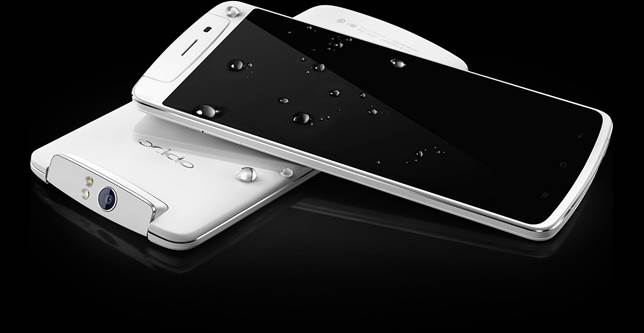If you never hear about the Chinese Oppo
brand name, we won’t blame you for that. It would actually be wise of us to
point out that the company has been making a rapid expansion all around Asia
recently. And we got a chance to review the company's flagship phone, the Oppo
N1.
The N1 is powered by a Qualcomm Snapdragon
600 SoC, which by today's standard, would be considered as a mid-end chip when
compared to the more powerful Snapdragon 800 series SoCs. Don't get us wrong:
the phone is still fast and was extremely responsive to the touch. Couple that
with a healthy amount of RAM (2GB, to be precise), and you'll never likely to
experience a laggy moment on the phone.

The
Oppo N1 is designed for effortless selfies
Notably, we should mention that the N1's
5.9-inch display is actually praiseworthy. Text and images are sharp and show
no loss of detail, even when zoomed in. Oppo has been smart by opting for an
IPS LCD display rather than using a Super AMOLED display, which actually works
to the N1's benefit as the colors on the screen don't look overly saturated or
extremely whitewashed.
But the most amazing thing about the N1 is
its fully rotatable, swivel operated camera. You think we're exaggerating about
this, but the N1's camera is genuinely a technologically marvel in its own
right. Oppo had its engineers fuss so much over it because the company didn't
want its flagship to be just another phablet: they wanted a masterpiece. The
end result of this obsession is a 13MP camera built with over 60 components
that can be rotated to the front and used to snap a 13MP selfie.

The
N1 camera features a rotation of 206° and will firmly lock in position at any
angle
However, there are a couple of tradeoffs
for this photographic benefit. First off, the N1 has no expandable storage
beyond its internal capacity, which means what you see is what you get. The
second tradeoff is the lack of 4G LTE support. There is an upside to the lack
of 4G connectivity and that's a battery life that lasted us two days on a full
charge and standard usage.
Additionally, the N1 is also equipped with
a functional backpad, which allows users to perform a multitude of tasks by
either tapping or swiping across the rear surface.
To test the N1, we subjected the phone to
our synthetic benchmark tests. At the end of the day, the N1 yielded scores of
34,764 for AnTuTu, 15,845 for 3DMark and 22,598 for Quadrant, which are
obviously very impressive. On our Epic Citadel benchmark, the N1 managed an
average of 28 FPS on the Ultra High Quality settings.

The
phone body is made with a smooth, delicate material for a ceramic-like
elegance, designed to keep your device free of fingerprints and eternally soft
to the touch
In conclusion, the Oppo N1 is a phone that
definitely ticks off all the boxes for being a photo- centric smartphone.
Again, it's a smartphone that actually lets you snap clear and sharp 13MP
selfies, making it one of the most photogenic smartphones on our list to date.
|
Specifications
·
Network: HSDPA ·
Camera: 13MP Rotatable Camera ·
Display: 5.9-inch (1920 X 1080) IPS LCD ·
OS: Android 4.2.2 Jelly Bean ·
Price: $554.94 (32GB) ·
Processor: 1.7GHz Quad-Core Qualcomm
Snapdragon 600 Processor ·
GPU: Adreno 320 ·
Multimedia Audio: aac, .amr, .m4a, .mp3, .wav,
.asf (version 9 and 10), .flac ·
Video: .3gp, .3g2, .mp4, m4v, asf, .wmv
(version 9 and 10) ·
Connectivity: 3.5mm stereo audio, micro
USB2.0, Wi-Fi IEEE 802.11 a/b/g/n, Bluetooth 4.0, USB OTG ·
Memory: 2GB RAM, 32GB internal storage, no
expandable microSD slot ·
Color: White ·
Dimensions: 180 (H) x 82.6 (W) x 9 (D) mm ·
Weight: 213g w/ battery ·
Battery: 3,610 mAh Li-Ion (non-removable)
|